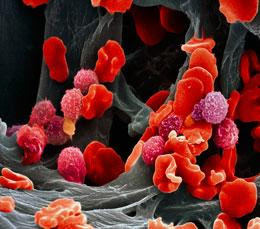 It vindicates the cancer researchers who believe that cells are very smart drugs.
It vindicates the cancer researchers who believe that cells are very smart drugs.
Two weeks after receiving an experimental treatment for his cancer, David Porter's 65-year-old leukaemia patient seemed to take a turn for the worse. Fatigue and fever drove the patient back to hospital, where his temperature surged to more than 39º C and he began to shake, his body racked with nausea and diarrhoea.
But rather than being a clinical failure, the patient's return to hospital heralded the treatment's success. His symptoms were the dying scream of more than a kilogram of leukaemia cells under attack by genetically engineered immune cells called T cells that Porter, an oncologist at the University of Pennsylvania Medical Center in Philadelphia, and his colleagues had infused two weeks earlier. As the T cells destroyed their targets, the sheer volume of cellular debris temporarily overwhelmed the patient's body.
Cells may be smart, but researchers have struggled to harness that intelligence to fight cancer. Early attempts to engineer T cells with chimeric antigen receptors failed to coax the cells to proliferate in the body. As a result, the modified cells soon died off, leaving little impact on the disease.
Porter's group is one the first to report results from a generation of chimeric receptors that include both an antibody to target the cancer and part of a receptor that amplifies the T-cell response. This time, the doctored T cells proliferated more than 1,000-fold in the body, and were still present at high levels six months after the treatment.
June credits this expansion and persistence for the study's dramatic results: two patients in complete remission and a third showing a partial response. The treatment kills off normal antibody-producing B cells too, but patients can be given regular infusions of antibodies to compensate for this, Porter says.
"I was sure the war was on," the patient, who has asked to remain anonymous, wrote in a statement released to reporters. "It was another week later that I got the news that my bone marrow was completely free of detectable disease."
-
References
- Porter, D. L. et al. N. Engl. J. Med. doi:10.1056/nejmoa1103849 (2011).
- Kalos, M. et al. Sci. Transl. Med. 3, 95ra73 (2011).
- Morgan, R. A. et al. Mol. Ther. 18, 843-851 (2010). | Article | PubMed | ISI | ChemPort |
- Brentjens, R., Yeh, R., Bernal, Y., Riviere, I. & Sadelain, M. et al. Mol. Ther. 18, 666-668 (2010). | Article | PubMed | ISI | ChemPort |
- Kochenderfer, J. N. et al. Blood 116, 4099-4102 (2010). | Article | PubMed | ISI | ChemPort |
You can read the entire article here